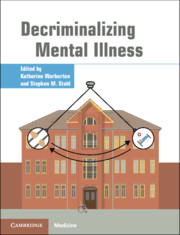Book contents
- Decriminalizing Mental Illness
- Decriminalizing Mental Illness
- Copyright page
- Contents
- Contributors
- Part I Introduction/Description of the Problem
- Part II Solutions
- Part III Psychopharmacological Treatment Considerations
- Part IV Nonpsychopharmacological Treatment Considerations
- Chapter 21 Neurocognition and Social Cognition Training as Treatments for Violence and Aggression in People with Severe Mental Illness
- Chapter 22 Examining Violence Among Not Guilty by Reason of Insanity State Hospital Inpatients Across Multiple Time Points: The Roles of Criminogenic Risk Factors and Psychiatric Symptoms
- Chapter 23 Criminogenic Risk and Mental Health: A Complicated Relationship
- Chapter 24 Implementation of a Specialized Treatment Program to Reduce Violence in a Forensic Population
- Chapter 25 From Trauma-Blind to Trauma-Informed: Rethinking Criminalization and the Role of Trauma in Persons with Serious Mental Illness
- Chapter 26 The Indistinguishables: Determining Appropriate Environments for Justice-Involved Individuals
- Chapter 27 Breaking Down Long-Term Chronic Aggression Within a Forensic Hospital System
- Part V Criminal Justice and Social Considerations
- Index
- References
Chapter 23 - Criminogenic Risk and Mental Health: A Complicated Relationship
from Part IV - Nonpsychopharmacological Treatment Considerations
Published online by Cambridge University Press: 19 October 2021
- Decriminalizing Mental Illness
- Decriminalizing Mental Illness
- Copyright page
- Contents
- Contributors
- Part I Introduction/Description of the Problem
- Part II Solutions
- Part III Psychopharmacological Treatment Considerations
- Part IV Nonpsychopharmacological Treatment Considerations
- Chapter 21 Neurocognition and Social Cognition Training as Treatments for Violence and Aggression in People with Severe Mental Illness
- Chapter 22 Examining Violence Among Not Guilty by Reason of Insanity State Hospital Inpatients Across Multiple Time Points: The Roles of Criminogenic Risk Factors and Psychiatric Symptoms
- Chapter 23 Criminogenic Risk and Mental Health: A Complicated Relationship
- Chapter 24 Implementation of a Specialized Treatment Program to Reduce Violence in a Forensic Population
- Chapter 25 From Trauma-Blind to Trauma-Informed: Rethinking Criminalization and the Role of Trauma in Persons with Serious Mental Illness
- Chapter 26 The Indistinguishables: Determining Appropriate Environments for Justice-Involved Individuals
- Chapter 27 Breaking Down Long-Term Chronic Aggression Within a Forensic Hospital System
- Part V Criminal Justice and Social Considerations
- Index
- References
Summary
The relationship between criminogenic risk and mental illness in justice-involved persons with mental illness (PMI) is complex and poorly understood. As previously noted, the general public is misinformed on the nature of this relationship, erroneously believing that mental illness causes violence and crime. This perception is compounded by news reports immediately speculating about mental illness in response to sensationalized criminal acts such as mass shootings, as well as in popular and social media. Of greater concern, however, is when clinicians, administrators, and policymakers are also misinformed. Criminal risk includes static (e.g. age, gender) and dynamic (e.g. antisocial attitudes, substance misuse) factors that place an individual at greater risk of involvement in crime.
- Type
- Chapter
- Information
- Decriminalizing Mental Illness , pp. 241 - 250Publisher: Cambridge University PressPrint publication year: 2021

